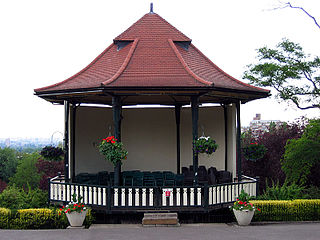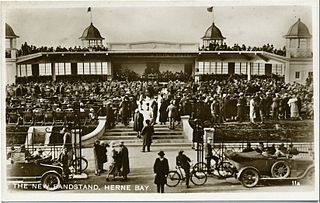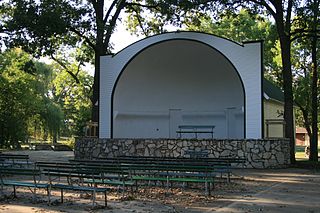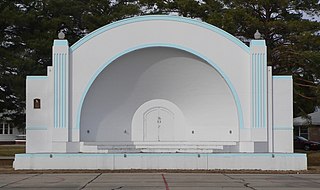
Oskaloosa is a city in, and the county seat of, Mahaska County, Iowa, United States. In the late nineteenth and early twentieth century, Oskaloosa was a national center of bituminous coal mining. The population was 11,558 in the 2020 U.S. Census, an increase from 10,938 in 2000.

Fulton is a city in the western part of Oswego County, New York, United States. The population was 11,896 as of the 2010 census. The city is named after Robert Fulton, the inventor of the steamboat.

Marshfield is in Wood and Marathon counties in the state of Wisconsin. It is located at the intersection of U.S. Highway 10, Highway 13 and Highway 97. The largest city in Wood County, its population was 18,929 at the 2020 census. Of this, 18,119 were in Wood County, and 810 were in Marathon County. The city is part of the United States Census Bureau's Marshfield-Wisconsin Rapids Micropolitan Statistical Area, which includes all of Wood County. The portion of the city in Marathon County is part of the Wausau Metropolitan Statistical Area.

A bandstand is a circular, semicircular or polygonal structure set in a park, garden, pier, or indoor space, designed to accommodate musical bands performing concerts. A simple construction, it both creates an ornamental focal point and also serves acoustic requirements while providing shelter for the changeable weather, if outdoors. In form bandstands resemble ornamental European garden gazebos modeled on outdoor open-sided pavilions found in Asian countries from early times.
The Pacific National Exhibition (PNE) is a nonprofit organization that operates an annual 15-day summer fair, 10-day winter fair, a seasonal amusement park, and indoor arenas in Vancouver, British Columbia, Canada. The PNE fair is held at Hastings Park, beginning in mid-to-late August and ending in early September, usually Labour Day, and in mid-December until Christmas.

Edwin Franko Goldman was an American composer and conductor. One of the most significant American band composers of the early 20th century, Goldman composed over 150 works, but is best known for his marches. He founded the renowned Goldman Band of New York City and the American Bandmasters Association. Goldman's works are characterized by their pleasant and catchy tunes, as well as their fine trios and solos. He also encouraged audiences to whistle/hum along to his marches. He wrote singing and whistling into the score of "On the Mall".
In Sweden, a folkpark is a public recreation space, usually featuring large grassed areas, trees, children's play facilities, etc. Most towns and cities have a folkpark. These parks were originally created by the labour movement as places where political rallies could be held and where workers and their families could unwind. In larger folkparks, there is sometimes a bandstand or stage, and they are used for concerts and other entertainment. Summer folkpark tours are a traditional part of the touring circuit for bands, etc.

Victoria Park is centrally located in the city of Hamilton, Bermuda. It is a public park that is opened daily to the public during daylight hours. It is widely used as an entertainment venue for free concerts and the like. There is also a rather attractive bandstand in the middle of the park, installed in 1889 in commemoration of the Golden Jubilee of Queen Victoria, and renewed in 2008. The park also contains attractive flower gardens and several species of endemic plants and trees. The park takes up a full block, with a number of benches and public restrooms. The park is bordered by Victoria Street, Washington Street, Dundonald Street and Cedar Avenue. It is under the administration of the Corporation of Hamilton.

Marshfield Clinic Health System is an integrated health system serving Wisconsin founded in 1916. The system contains several hospitals and many clinics throughout Wisconsin, as well as a medical research institute and an education division, and employs more than 1,200 doctors and other clinicians.

Breese Stevens Municipal Athletic Field is a multi-purpose stadium in Madison, Wisconsin. Located eight blocks northeast of the Wisconsin State Capitol on the Madison Isthmus, it is the oldest extant masonry grandstand in Wisconsin.

Enghaveparken is a public park in the Vesterbro district of Copenhagen, Denmark. It was laid out in the late 1920s to cater for the citizens of the expanding city. The park is completely closed off while undergoing comprehensive renovations June 2018-December 2019.

This is a list of the National Register of Historic Places listings in Wood County, Wisconsin. It is intended to provide a comprehensive listing of entries in the National Register of Historic Places that are located in Wood County, Wisconsin. The locations of National Register properties for which the latitude and longitude coordinates are included below may be seen in a map.

De Waal Park is a public park and heritage site in the Oranjezicht suburb of Cape Town. The park, which contains over 120 species of trees, is popular with dog walkers.

The Central Bandstand, known as the Bandstand, in Herne Bay, Kent, England, was designed by H. Kempton Dyson in 1924, extended with an art deco frontage in 1932, and refurbished between 1998 and 1999. It is one of the coastal landmarks of the town. When first built, it was a popular venue for visiting military band concerts and for tea dances. Edwina Mountbatten spoke there on behalf of the Red Cross in 1939. In the 1920s and 1930s a red carpet would be laid across the road and up to the stage for the conductor of the brass band to walk from the Connaught Hotel which was directly opposite the Bandstand.

The East Park Band Shell is a historic structure located in Mason City, Iowa, United States. The band shell was individually listed on the National Register of Historic Places in 2009. In 2014 it was included as a contributing property in the East Park Historic District.

The Athletic Park Band Shell in Plainview, Nebraska was designed and built during 1939 to 1942. Also known as Plainview Band Shell, it was listed on the National Register of Historic Places in 1992.

The Marshfield Central Avenue Historic District is part of the old downtown of Marshfield, Wisconsin. The original wooden downtown burned in a huge fire in 1887. Some of the brick buildings built immediately after the fire still stand - especially near the railroad. Other buildings were added later, and the district includes some off Central, like the old city hall and the depot.



















